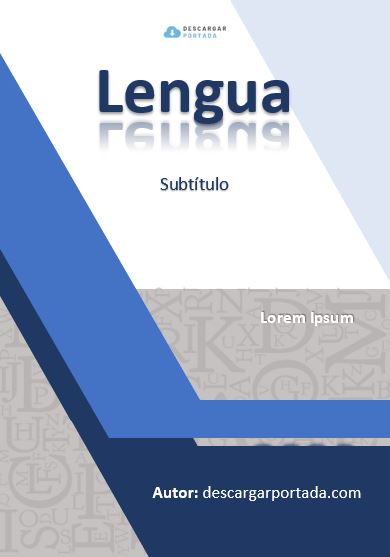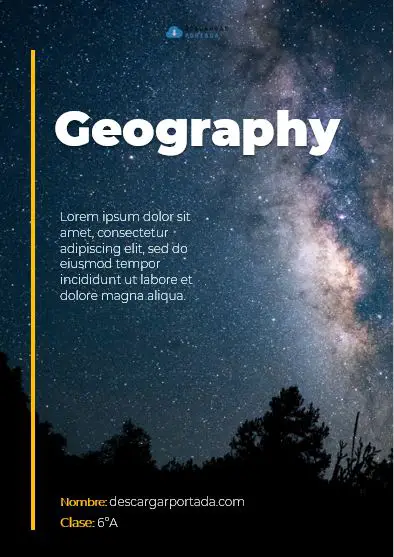Computing Cover pages
Find the best selection of cover pages for computer science, computing, programming or Information and Communication Technologies (ICT). All of them have a technological theme.
We always remember that it is important to check if there are some prerequisites when making the cover or the cover of computer science in question. Since we can find ourselves more than once in some project, in which we do not have total freedom at the time of realizing its cover.
Below you can see how one of our covers can look like in reality, in a notebook or a work of a subject.

❔ Frequently asked questions (FAQ)
How to edit a cover page?
To edit the cover page, follow these steps:
- Download the Word file of the cover page you want.
- Open the .docx document by double clicking on it.
- To change the sample texts with your information, simply click on them. Depending on the type of cover you download, you will be able to modify more or less elements (background image, decorative elements, etc…). In the description of their file you can find the characteristics of each one.
- To finish, modify the elements you want to your liking, and press the “Ctrl+G” keys to save your new language cover. You are done!
How should I structure an academic paper?
1. Coverpage.
The following must appear on it: the organization in whose framework the work is carried out, with or without logo, the title and subtitle of the work, the author’s name, the name of the tutor or professor responsible, the academic year in which it is presented and a brief text indicating what type of work it is (course work, final thesis, master’s thesis, etc.).
2. Index.
It should reflect the different sections or chapters that make up the work. They must be numbered and paginated.
3. Introduction.
This should be written at the last moment, even after the conclusions, since it should help us to understand the work. It includes the approach of the subject, its chronological and geographical limits, as well as those aspects that are considered essential to understand the subject of the study (motivations, methodology, objectives, state of the question and acknowledgements).
4. Body of work.
This is the most extensive and laborious point of the work, it collects all those approaches that have been reached after the search and analysis of the bibliography and the own deductions.
5. Conclusions.
In this section it should be noted which of the objectives set out in the introduction have been achieved, which hypotheses have been demonstrated and what are the main contributions of the work. As well as problems or questions that are still pending.
6. Sources and bibliography.
In the last part of the work, we must include all bibliographic references and sources of information used for the preparation of the work. There are different citation methodologies. Normally these references are usually arranged in alphabetical order.
7. Graphic material.
All graphic material (illustrations, maps, photos, etc.) can be placed either in the appendix or in the body of the paper. It must have a caption preceded by a number, which will help us to identify the image within the text.
8. Appendices or annexes.
After the bibliography we can include one or more appendices with illustrations, photographs, documents or any other material that may contribute information of interest to the work. The appendices or annexes and their subsections should be numbered, so that they can be cited throughout the work, in the text itself, not in a footnote.
How to make a computer cover
Tastes are very varied, so there is a possibility that our computer cover pages designs do not quite fit the type you are looking for. So you can always handcraft the cover you have in mind. For this, we leave you the following video to get an idea of how to make a cover of this type.
Ideas to make a computer cover
Have you run out of ideas for decorating your computer covers? No problem, you will be the most original in your class with these ideas for your covers:
- Use different types of paint to decorate it (wax, watercolor, markers, etc.).
- Use different artistic techniques to decorate it, such as collage.
- Add elements that are related to the subject, as for example in this case: computers, computer symbols, images related to technology, etc…
Download your covers pages in the most secure way
From descargarportada.com we believe that security is very important. For that reason, we host our content in Mediafire so that your downloads are totally safe, and our content is protected against any attack.
We remind you that downloading any type of file directly from any unknown site can pose a risk to our pc, so we advise you to check the reliability of the pages before downloading any type of file.
On our site, when downloading the covers from the Mediafire platform, you don’t have to worry. The download is not done directly from our site to maximize your security.
🔒 We believe that security is very important, both for you and for us. That’s why we take all the necessary security measures and host our covers on Mediafire. This way, we can guarantee, that downloads are totally safe, and our content is kept safe from any kind of attack.















